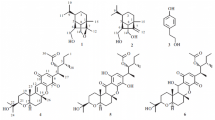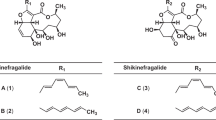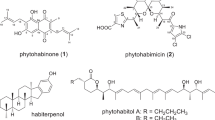Abstract
A strain of Biatriospora sp. CCF 4378 was tested for the production of secondary metabolites under submerged fermentation conditions. Eleven compounds were isolated from the culture broth, and the structures of these compounds were determined using HRMS, NMR and X-ray analysis. In addition to six known naphthoquinone derivatives, i.e. ascomycone A, ascomycone B, 6-deoxyfusarubine, 6-deoxyanhydrofusarubine, herbarine and balticol A, one derivative of 2-azaanthraquinone, 6-deoxybostrycoidine, was also identified. Four new natural pyranonaphthoquinones were found, and these natural products were pleorubrin A, pleorubrin B, pleorubrin C and pleorubrin D. The toxicity on human cell lines of the crude naphthoquinone fraction and pure 6-deoxybostrycoidin, ascomycone B, pleorubrin B and 6-deoxyfusarubin was tested. Ascomycone B and 6-deoxyfusarubin elicited rapid cytotoxicity at micromolar concentrations.






Similar content being viewed by others
Abbreviations
- DMSO:
-
Dimethyl sulfoxide
- ESI:
-
Electrospray Ionisation
- HMBC:
-
Heteronuclear multiple-bond correlation
- HPLC:
-
High-performance liquid chromatography
- HRMS:
-
High-resolution mass spectrometry
- ITS:
-
Internal transcribed spacer
- LDI:
-
Laser desorption/ionisation
- LSU rDNA:
-
Large-subunit ribosomal DNA
- NMR:
-
Nuclear magnetic resonance
- PBS:
-
Phosphate-buffered saline
- SSU rDNA:
-
Small-subunit ribosomal DNA
References
Altschul SF, Madden TL, Schaffer AA, Zhang JH, Zhang Z, Miller W, Lipman DJ (1997) Gapped BLAST and PSI-BLAST: a new generation of protein database search programs. Nucleic Acids Res 25:3389–3402
Angelini P, Rubini A, Gigante D, Reale L, Pagiotti R, Venanzoni R (2012) The endophytic fungal communities associated with the leaves and roots of the common reed (Phragmites australis) in Lake Trasimeno (Perugia, Italy) in declining and healthy stands. Fungal Ecol 5:683–693
Baker RA, Tatum JH, Nemec S (1990) Antimicrobial activity of naphthoquinones from fusaria. Mycopathologia 111:9–15
Bell AA, Wheeler MH, Liu JG, Stipanovic RD (2003) United States Department of Agriculture—Agricultural Research Service studies on polyketide toxins of Fusarium oxysporum f. sp. vasinfectum: potential targets for disease control. Pest Manag Sci 59:736–747
Brimble MA, Duncalf LJ, Nairn MR (1999) Pyranonaphthoquinone antibiotics—isolation, structure and biological activity. Nat Prod Rep 16:267–281
Hussain H, Krohn K, Ahmed I, Draeger S, Schulz B, Di Pietro S, Pescitelli G (2012) Phomopsinones A-D: four new pyrenocines from endophytic fungus Phomopsis sp. Eur J Org Chem:1783–1789
Jadulco R, Brauers G, Edrada RA, Ebel R, Wray V, Sudarsono PP (2002) New metabolites from sponge-derived fungi Curvularia lunata and Cladosporium herbarum. J Nat Prod 65:730–733
Kolařík M, Jankowiak R (2013) Vector affinity and diversity of Geosmithia fungi living on subcortical insects inhabiting Pinaceae species in central and northeastern Europe. Microb Ecol 66:682–700
Koyama J, Morita I, Kobayashi N, Osakai T, Usuki Y, Taniguchi M (2005) Structure-activity relations of azafluorenone and azaanthraquinone as antimicrobial compounds. Bioorg Med Chem Lett 15:1079–1082
Narasimh N, Gopalkri KS (1974) Naphthoquinone pigments from Torula herbarum—structure of methylherbarin. J Antibiot 27:283–287
Opatz T, Kolshorn H, Thines E, Anke H (2008) Ascomycones A-C, heptaketide metabolites from an unidentified ascomycete. J Nat Prod 71:1973–1976
Panno L, Bruno M, Voyron S, Anastasi A, Gnavi G, Miserere L, Varese GC (2013) Diversity, ecological role and potential biotechnological applications of marine fungi associated to the seagrass Posidonia oceanica. New Biotechnol 30:685–694
Paranagama PA, Wijeratne EMK, Burns AM, Marron MT, Gunatilaka MK, Arnold AE, Gunatilaka AAL (2007) Heptaketides from Corynespora sp. inhabiting the cavern beard lichen, Usnea cavernosa: first report of metabolites of an endolichenic fungus. J Nat Prod 70:1700–1705
Parisot D, Devys M, Ferezou JP, Barbier M (1983) Pigments from Nectria haematococca, anhydrofusarubin and nectriafurone. Phytochemistry 22:1301–1303
Parisot D, Devys M, Barbier M (1989) 5-Deoxybostrycoidin, a new metabolite produced by the fungus Necteria haematococca (Berk and Br) WR. Z Naturforsch B J Chem Sci 44:1473–1474
Parisot D, Devys M, Barbier M (1992) Heptaketide derived polyenes from the fungus Necteria haematococca. Phytochemistry 31:4357–4358
Pažoutová S, Šrůtka P, Holuša J, Chudíčková M, Kubátová A, Kolařík M (2012) Liberomyces gen. nov. with two new species of endophytic coelomycetes from broadleaf trees. Mycologia 104:198–210
Piggott MJ (2005) Naphtho[2,3-c]furan-4,9-diones and related compounds: theoretically interesting and bioactive natural and synthetic products. Tetrahedron 61:9929–9954
Qiancutrone JF, Gao Q, Huang S, Klohr SE, Veitch JA, Shu YZ (1994) Arthrinone, a novel fungal metabolite from Arthrinium sp. FA-1744. J Nat Prod 57:1656–1660
Qin S, Krohn K, Hussain H, Schulz B, Draeger S (2011) Pestalotheols E-H: antimicrobial metabolites from an endophytic fungus isolated from the tree Arbutus unedo. Eur J Org Chem: 5163–5166
Schüffler A, Liermann JC, Kolshorn H, Opatz T, Anke H (2009a) Isolation, structure elucidation, and biological evaluation of the unusual heterodimer chrysoxanthone from the ascomycete IBWF11-95A. Tetrahedron Lett 50:4813–4815
Schüffler A, Liermann JC, Kolshorn H, Opatz T, Anke H (2009b) New naphthoquinone derivatives from the ascomycete IBWF79B-90A. Z Naturforsch C Biosci 64:25–31
Sheldrick GM (2008) A short history of SHELX. Acta Crystallogr A 64:112–122
Shushni MAM, Mentel R, Lindequist U, Jansen R (2009) Balticols A-F, new naphthalenone derivatives with antiviral activity, from an ascomycetous fungus. Chem Biodivers 6:127–137
Shushni MAM, Singh R, Mentel R, Lindequist U (2011) Balticolid: a new 12-membered macrolide with antiviral activity from an ascomycetous fungus of marine origin. Mar Drugs 9:844–851
Shushni MAM, Azam F, Lindequist U (2013) Oxasetin from Lophiostoma sp of the Baltic sea: identification, in silico binding mode prediction and antibacterial evaluation against fish pathogenic bacteria. Nat Prod Comm 8:1223–1226
Simamura E, Hirai KI, Shimada H, Koyama J, Niwa Y, Shimizu S (2006) Furanonaphthoquinones cause apoptosis of cancer cells by inducing the production of reactive oxygen species by the mitochondrial voltage-dependent anion channel. Cancer Biol Ther 5:1523–1529
Sperry J, Bachu P, Brimble MA (2008) Pyranonaphthoquinones—isolation, biological activity and synthesis. Nat Prod Rep 25:376–400
Sperry J, Yuen TY, Brimble MA (2009) Enantioselective synthesis of the 3C-protease inhibitor (−)-thysanone by a Stauton-Weinreb annulation strategy. Synthesis 2009:2561–2569
Stipanovic RD, Zhang JX, Bruton BD, Wheeler MH (2004) Isolation and identification of hexaketides from a pigmented Monosporascus cannonballus isolate. J Agric Food Chem 52:4109–4112
Suetrong S, Schoch CL, Spatafora JW, Kohlmeyer J, Volkmann-Kohlmeyer B, Sakayaroj J, Phongpaichit S, Tanaka K, Hirayama K, Jones EBG (2009) Molecular systematics of the marine Dothideomycetes. Stud Mycol 64:155–173
Tatum JH, Baker RA, Berry RE (1987) Naphthofurans produced by Fusarium oxysporum isolated from citrus. Phytochemistry 26:2499–2500
Thomson RH (1971) Naturally occurring quinones, 2nd edn. Academic Press, New York
Van Wagoner RM, Mantle PG, Wright JLC (2008) Biosynthesis of scorpinone, a 2-azaanthraquinone from Amorosia littoralis, a fungus from marine sediment. J Nat Prod 71:426–430
Whyte AC, Gloer KB, Gloer JB, Koster B, Malloch D (1997) New antifungal metabolites from the coprophilous fungus Cercophora sordarioides. Can J Chem 75:768–772
Yamamoto Y, Kinoshita Y, Thor GR, Hasumi M, Kinoshita K, Koyama K, Takahashi K, Yoshimura I (2002) Isofuranonaphthoquinone derivatives from cultures of the lichen Arthonia cinnabarina (DC.) Wallr. Phytochemistry 60:741–745
Acknowledgments
This work was supported by the LD-COST CZ project LD13039, Czech Science Foundation project No. 13-16565S, Long-Term Research Plans of the Ministry of Education, Youth and Sports of the Czech Republic No. MSM0021620858, and Charles University projects UNCE 204013/2012. Access to instrumental and other facilities was also supported by the EU (Operational Program Prague–Competitiveness project CZ.2.16/3.1.00/24023) and by the IMIC institutional research concept RVO61388971.
Author information
Authors and Affiliations
Corresponding author
Electronic supplementary material
Below is the link to the electronic supplementary material.
ESM 1
(DOCX 170 kb)
Rights and permissions
About this article
Cite this article
Stodůlková, E., Man, P., Kuzma, M. et al. A highly diverse spectrum of naphthoquinone derivatives produced by the endophytic fungus Biatriospora sp. CCF 4378. Folia Microbiol 60, 259–267 (2015). https://doi.org/10.1007/s12223-014-0366-7
Received:
Accepted:
Published:
Issue Date:
DOI: https://doi.org/10.1007/s12223-014-0366-7




